
July 3, 2009
4:26 PM
4:26 PM
Introducing The Bridge
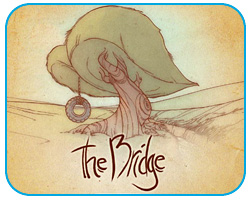 Next up in our series of games from the Spring 2009 semester is The Bridge, another arthouse game from Doris C. Rusch, the product owner of last summer's Akrasia. This game, a rumination on loss and mourning, is now available to play. You may want to check it out before reading the following reflection from Doris on the game's creation - there are spoilers ahead! - but definitely do come back and give the following essay a read, to share in Doris' experiences with game design as its own personally reflective, insightful process. -Geoff
Next up in our series of games from the Spring 2009 semester is The Bridge, another arthouse game from Doris C. Rusch, the product owner of last summer's Akrasia. This game, a rumination on loss and mourning, is now available to play. You may want to check it out before reading the following reflection from Doris on the game's creation - there are spoilers ahead! - but definitely do come back and give the following essay a read, to share in Doris' experiences with game design as its own personally reflective, insightful process. -Geoff
The Bridge: Game Design as a Tool for Reflection and Self-Exploration
by Doris C. Rusch
The Bridge is a short, single player Flash game, made during the spring semester of 2009 by a team of students. I was the product owner and lead designer of this project. Although I have my doubts regarding The Bridge's qualities as a game (for which I take full responsibility), I still regard it as one of the most interesting works I've ever done. The focus, however, is on "work" as in "process", not the result. Working on The Bridge showed me what a wonderful tool for self-reflection and insight game design can be. The following is an account of how using the tools of my craft helped me and two of my team members to more clearly map out our emotional landscapes. Feel free to try this at home!
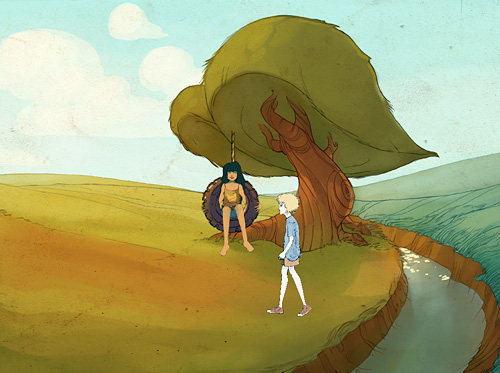
Guided by Images
Saying I wanted to make a game about "mourning" or the connection between "love" and "fear of loss" would be bullshitting (Def. bullshitting: terminus technicus for making a process appear intentional and focused in hindsight when it actually was not). So, let's just stick to the dirty truth of how it really went.It started with an image of an empty tire swing that suddenly bubbled to the surface of my subconscious but never quite made it into the more analytical realm of my mind. The image didn't come with an explanation, only with an emotional overtone of loss, frustration and hoping against hope. A bit like a cone without ice cream, a tire-swing is a sad affair when it just hangs there without a child on it. Of course, one can take either image both ways: as a promise for future fun or as the memory of past pleasures. In the moment my mind decided to release the tire swing from its swampy depths, I gravitated towards the darker reading of it. But why a tire swing? Why not a more traditional metaphor for loss, such as a gravestone or a couple dressed in black, huddled together under an umbrella?
How I would love to be able to give a clever and coherent explanation now. But I vowed to adhere to honesty and will thus further refrain from bullshitting. The best I can do is share the stream of associations with you that (to me) accompanied the tire-swing metaphor.
Imagine being the one pushing the swing with the child on it. You push, you watch the swing perform the familiar motion, you wait for it to come back to you, and you push it again. The "here-gone" dichotomy strongly resonated with me. The necessity of letting go of the swing in order for it to fulfill its purpose (i.e. provide a pleasurable experience for the child) and at the same time distancing yourself from the precious freight it carries, experiencing a moment of anticipation (anxiety?) before the swing starts to come back, and the relief upon its safe return. But this relief is not really due to the return of the swing, but to the return of the child on it. In most cases, these two things are coupled. While the cycle of the swing will not be interrupted as long as one keeps pushing (what goes up must come down, right?), it is possible to lose a person forever. Fate is less predictable than physics. If the swing is "gone" it will transform into "here" again. A person, once dead, will remain gone. Child and swing - once fused together - are indeed separate entities; they can part ways. The stubborn mind, however, is reluctant to dissociate the two. The swing has always brought the child back, so maybe pushing an empty swing will magically return what has been lost. But some things cannot be changed, no matter how hard we push...
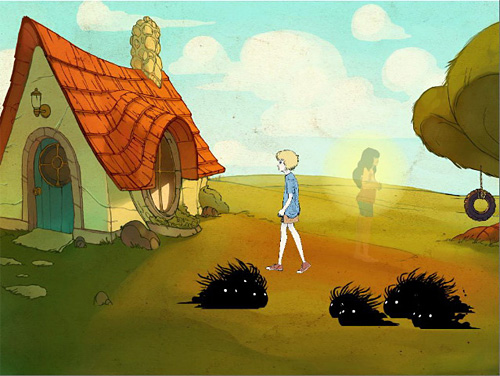
The Initial Idea
The interactive piece I initially envisioned (I wasn't even going to call it a game!) was strongly inspired by this crude image of an empty tire-swing and the foggy feelings of loss and mourning I associated with it. The player would enter an empty space with nothing but a swing in it and nothing to do but to push it. Pushing the swing would produce faint laughter and the transparent outline of a child would become visible on the swing. The implied goal would be to push until the child materialized completely. In truth, no such thing would be possible, though. The player would have to realize that all her efforts were for naught, that there was no way of bringing the child to life and that the only way to "win" was to accept that and walk away. In order to make this (emotionally) difficult for the player, every time she stopped pushing, the child would fade again, the laughing would grow faint at first, then maybe turn into whimpering (good audio would be required for this or instead of inducing guilt, the whining would create the wish to quickly leave the wretched child behind).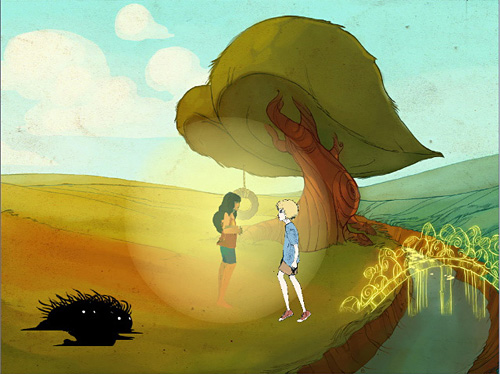
Using "The Tools" for Self-Exploration: A Conversation With The Inner Game Designer
When I talked to my friends Jaroslav and Eric about this initial idea - both very game savvy - they saw the potential for an emotionally compelling experience. However, they thought it should be more "gamey". I was reluctant at first. The simple tire-swing sequence felt so right that I wanted to do it exactly as I had described above. And then, they popped the Question (yep, it deserves the capital letter): "But what exactly is this about?" Mourning, clinging, loss, attachment - whatever I said to explain it didn't quite capture it. I couldn't put it in words. Since I'm strongly advocating purposeful design, not knowing my own mind was a problem. How can I purposefully create an experience for someone else if I don't understand my own feelings?This had to change. I decided to follow my friends' advice and make it more "gamey". Because although the game itself can be ambiguous and allow multiple interpretations, coming up with the rules forces the designer to be precise and concrete. I started to explore what I already had in mind in terms of game elements. Here's a rough transcript of the dialogue I had with what I call my "Inner Game Designer" (IGD):
IGD: What exactly is the GOAL?I will spare you the rest of the conversation because it involved giant flying puddings and the monster with 14 toes, neither of which had any relevance to The Bridge. But you can see how the concept had dramatically evolved from the simple initial idea to a system that tackles the mechanisms of a certain kind of love and the problems that come with it. What was still lacking was an idea of how to overcome those problems, to get "unstuck" and break the pattern. Obviously, you had to fight your fears so you weren't dependent on your love object anymore and could love it in a more selfless way. And then what?
Me: To "let go".
IGD: A goal without CONFLICT makes for a lousy game. So what is the conflict? What makes "letting go" difficult?
Me: Attachment makes it difficult.
IGD: What creates attachment?
Me: Hm...love?
IGD: So, the way to overcome attachment is to overcome love?
Me: I don't think so. That would be terrible. Love is important.
IGD: Are you sure it is love, then, that bothers you? Maybe it's fear?
Me: Oh yeah? Well, what do YOU know?
IGD: I'm you, remember?
Me: Attachment and fear. Fear of losing love. You cling because you are afraid...
IGD: What exactly are you afraid of?
Me: Haven't I just said that? Afraid of losing love! Isn't that obvious?
IGD: Aren't you a bit negative?
Me: Don't play the Eliza trick on me!
IGD: All right, I'm sorry - couldn't resist. Seriously now, why would losing love be bad? It sounds like love serves a purpose.
Me: It protects...makes you feel good.
IGD: And since you don't want to lose what makes you feel good, love itself creates fear. It is both the curse and the cure, it seems.
Me: That's right. Fear creates clinging, you want to stay close to the "love object".
IGD: May I point out that you don't seem to have internalized love? It's this outside thing on which you depend. That attitude will always kick you in the butt.
Me: You're my inner game designer, not my freaking therapist.
IGD: Seems like pretty much the same thing to me...
It was at the speakers' party at this year's Game Developer's Conference in San Francisco when Trey (the game's producer) and Jamie (code and animation) approached me with the words: "we have been thinking." Sitting in front of cocktails called "The Game Designer" or "Achievement Unlocked", they spoke to me of closeness, emancipation and sacrifice in a serious and insightful way. We pondered how the game could end. We knew the goal, we had grasped the conflict. Now we had entered the final stage of the process: finding a solution. What happened when you killed the monsters that represented your fears? What happened to the girl that represented your love object? What exactly would "letting go" look like? It was Jamie who dumped the solution in my lap: every monster you killed would help form a bridge across the river that divided the playground (the game's main space) from the untended field (representing an unknown future). I loved the symbolism that the road to a better future was paved by one's conquered fears. We further entertained the rather disturbing idea that the girl would sacrifice herself to complete the bridge, that her (self-inflicted) death would produce the last missing piece. We let this sink in. Nah...no good, since it would undermine the emancipation process which depends on taking responsibility for one's actions. So, maybe the player had to kill the girl before the bridge solidified? No, no, no! Not reconcilable with the idea of selfless love! We finally agreed that to win the game, one would have to kill all the monsters in the playground and refrain from "reclaiming" the girl on the tire-swing. The bridge would solidify upon the death of the last monster and one could cross it. Crossing the bridge would "free" the girl (she'd dissolve into a could of particles). This should not mean that one abandoned love itself, but had overcome functionalizing it.
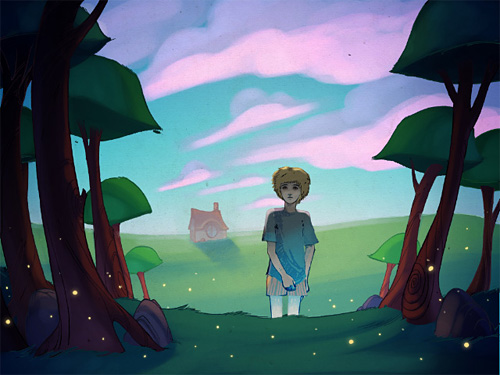
The True Reward Was The Journey
My team had an equivalent of two 40-hour work weeks to develop this game. This is not a lot of time, but they did an amazing job. Our biggest problem, however, was that the theme was so personal. If a project is too big, you can always scope it down. But if you are very invested in the concept you want to convey, to do it justice and get it right, the problem starts much sooner than scope. It starts with understanding what exactly you want to model.We tried something big with The Bridge. Too big, maybe, for the given timeframe. I felt bad for a while after our last official work session, because how can you close the book on "love" and walk away feeling like you've accomplished anything? Also, eighty hours of development time do not leave a lot of room for tweaking and polishing and thus many of the ideas in the game are still latent and could be communicated to players more clearly.
But then again, I have learned a lot. The process of designing this game made many things apparent to me, helped me map out some of my emotional landscape. In that regard, The Bridge was a huge success. It confirmed my belief that while making profound games that tackle the human condition is a worthy goal which I will keep pursuing, game design itself can be a wonderful tool for insight that greatly enhances our understanding of ourselves.


